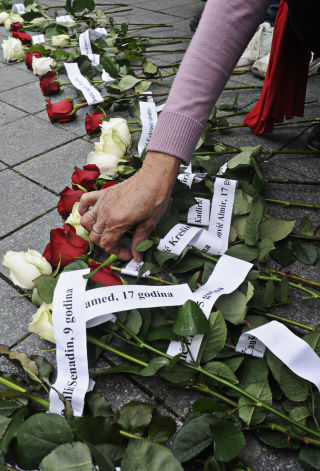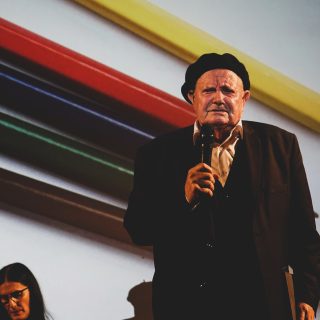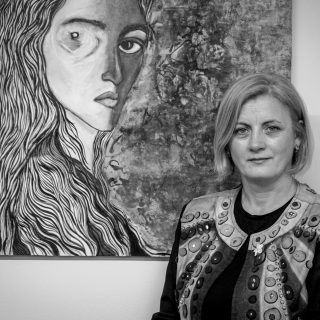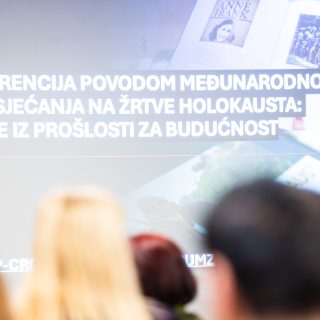Published on The New Yorker, November 04, 2015
BY NIDŽARA AHMETAŠEVIĆ
One of the largest massacres in Europe in the second half of the twentieth century took place in the small city of Prijedor, in northern Bosnia. In April, 1992, as the Bosnian war was beginning, the Bosnian Serb regime announced on the radio that it was taking over the town and the surrounding areas. On May 31st, Serb nationalists ordered all non-Serbs to mark their houses with white flags or sheets, and to wear a white armband if they left their homes. Over the next few months, they initiated mass expulsions of an estimated fifty thousand Bosniaks (Bosnian Muslims) and Bosnian Croats. An estimated twenty-five thousand people, including some women, children, and elderly people, were taken to concentration camps outside the town, where, according to the International Criminal Tribunal for the Former Yugoslavia (I.C.T.Y.), many were tortured or raped, and more than three thousand were killed. Massacres like this one were occurring across Bosnia, but, until Srebrenica, in 1995, none was larger than Prijedor.
Former residents began to come back to Prijedor in 1998, three years after the end of the war, but by 2007 less than a third had returned. In May, 2012, Emir Hodžić, a Bosniak who was expelled when he was fourteen, came back to his hometown for the first time. It was the twentieth anniversary of the crimes committed there, and he wanted to pay homage to those who had been tortured and killed. In 1992, his father and older brother were taken to the Omarska concentration camp, on the site of a mining complex outside Prijedor. They were held there for three months and tortured, and then transferred to another detention center. They were only released after the camps were discovered by a group of British and American journalists, who broadcast the images around the world. The camps were shut down, in November, 1992, but instead of remaining at home, Hodžić and his family were put on a convoy by the Bosnian Serbs and transported to the Croatian border, where they were handed off to the United Nations. They eventually settled in New Zealand.
When Hodžić returned to his hometown, in 2012, he put a strip of white cloth around his left arm and tried to enter Omarska, which is once again an active mine. Security guards stopped him at the entrance and threatened to call the police if he didn’t leave. Full of disbelief, he went back into Prijedor. “I was so, so angry,” Hodžić told me. Local organizations had planned a memorial ceremony, in which they had intended to lay out two hundred and sixty-six body bags, for the number of women and children who were killed in Prijedor, but the local government banned the event. Hodžić decided to see it through alone. He bought more white fabric that he laid out like a body bag and stood in the square by himself, for twenty minutes, in silence, hoping someone would approach and ask him what he was doing. Nobody came. “It was a very weird feeling, an overwhelming feeling of dehumanization, the same one I remembered from 1992. I was once again marked as ‘the other’ in the city where I was born,” Hodžić said. “Victims in Prijedor aren’t seen, and I wanted to show them, ‘You can’t erase me.’ ”
Hodžić had asked someone to take a picture of him, and he posted it on Facebook, on a page he had set up with a group of friends called Stop Genocide Denial. They had planned to start a campaign to make May 31st International White Armband Day, to honor all people who were killed because they were different, and the photo of Hodžić standing alone in the middle of the empty square went viral, rallying people to the cause.
Among Hodžić’s friends was Edin Ramulić, who was imprisoned when he was twenty-two, and whose father and brother were tortured and killed. Since 1999, Ramulić, who came back to Prijedor with the first returnees, has been involved in survivors’ groups and has tried to talk about what happened, but with little success. “It is like a story that belongs only to us, victims and survivors,” Ramulić said. “And, as long as we do not try to involve anybody else in that story, it’s O.K. But when we approach other people in Prijedor and try to engage them, it becomes a problem.” Ramulić came out to the square with six others, some of whom were Serbs, on May 31, 2012. They all wore white armbands and stood together in silence.
Thirty-seven people have been convicted and sentenced for crimes committed in Prijedor in the nineteen-nineties; the I.C.T.Y. sentenced twelve of them, while the others were tried domestically, in a war-crimes court in Sarajevo. The Sarajevo court has so far issued five hundred indictments, but the Bosnian public knows little about them. Even the ongoing trial in The Hague of Ratko Mladić, the Bosnian Serb military chief, has not been broadcast on TV or radio channels. Part of the problem is that, in both courts, “the process is about international lawyers and political élites,” Eric Gordy, a sociologist at University College London, whose work focusses on the former Yugoslavia, told me. “The tribunal and local courts never developed a clear idea of who their clientele was, never took enough of an interest in articulating or addressing the concerns of victims, or explaining to the local public what was being established and what it meant.”
(The Bosnian war-crimes court said in a statement that claims about a lack of outreach probably come from people “who do not know much about work of this institution. We consider transparency and public relations to be very important.” The court noted that most hearings are open to the public, and that it is involved in a series of public discussions, in coöperation with local organizations. It also argued that public interest in war-crimes proceedings is decreasing in Bosnia. “It is not possible to expect that twenty years after the war, people will have the same interest in war-crimes trials as they had ten or fifteen years ago,” the statement said. “It is natural, therefore, for media coverage to decrease as well.”)
A further challenge is posed by the Bosnian government, which has little interest in moving beyond the war’s divisions. The Dayton Agreement, which brought the war to a halt, in 1995, also instituted a governance structure that recognizes all of the warring ethnic groups as active parties. Dayton, which many say effectively froze the conflict in place, created a vast and complicated system: two “administrative entities” (Republika Srpska and the Federation of Bosnia and Herzegovina), three Presidents, and ten cantons, each with its own President, ministries, and parliament. There are more than a hundred and fifty government ministers at the various levels, in a country of less than four million people, and countless Bosnians are employed in the state apparatus. Dayton also made Bosnia what is often called a “semi-protectorate,” a country where the international community has ultimate authority over local governance structures. But the international community has redirected its energy into other conflicts, leaving Bosnia to its corrupt local élites. According to Transparency International, Bosnia today is one of the most corrupt countries in the region. It is also one of the poorest, with more than sixty per cent youth unemployment. Because of economic hardships, people of all ethnicities are leaving. Prijedor and its surrounding villages are once again becoming empty.
On August 5, 2012, several dozen people wearing white armbands gathered again at the main square in Prijedor. Among them was Fikret Bačić, whose twelve-year-old son and six-year-old daughter were killed, in 1992. Bačić wanted a memorial to be created for the hundred and two children who were killed in Prijedor, and this effort became a focus of future demonstrations. That day, people carried schoolbags, each one bearing the name of a child who was killed. Local authorities had forbidden the gathering, claiming that it could incite ethnic conflict, and that using the word “genocide” would give the town a bad name. The people who came ignored the government. I was among them, walking in a column that moved slowly down the main street, where cafés normally play loud music. On this day, the cafés were silent, and the patrons watched quietly, though they didn’t join us. When we reached the square, we set the schoolbags down in a pattern that spelled out the word “genocide,” to protest the government’s opposition. Some of the activists were local Serbs who were in the process of forming an organization called Kvart Youth Centre, which promotes dialogue in Prijedor about the war. After the gathering, local police brought several of the participants to the station for questioning, but soon let them go.
Goran Zorić works for Kvart, and, like most of Kvart’s members, he identifies as L.G.B.T. Zorić was eleven when the war started. At that time, all Serb men in the area were required to join the military apparatus, and Zorić’s late father, who had been a high-school teacher, became a member of the local police force, but he never spoke about what was happening all around them in Prijedor. About ten years ago, Zorić became active in promoting L.G.B.T. rights. Then he came out, first to his friends and later to his family. He remembers that not all people in Prijedor reacted well. “Once, I was beaten up badly on the street. Though I’m not sure if it was a hate crime, or just a matter of being at the wrong place at the wrong time,” he said. When Zorić joined the commemoration, in 2012, the mayor of Prijedor took the opportunity to label the event a “faggot parade.” “In this small, conservative, and homophobic town, it was a clear message about us as a group, that we cannot be accepted by society,” Zorić said. Nationalists threatened Zorić and the others, mostly through Facebook, though some people approached them on the streets or in cafés, insulting them and even, on one occasion, spitting in the face of one of Zorić’s friends. “Somebody wrote graffiti on the wall with my name and the word ‘faggot,’ with a swastika underneath it,” Zorić said. He has kept a picture of the graffiti.
The demonstrators didn’t let these threats deter them. In 2013 and 2014, even more people came to the May 31st demonstration in Prijedor. They carried a hundred and two white roses, each with the name of one of the murdered children. They laid the roses in a circle and read the names aloud. This past May, more than a thousand people came. Again, roses were laid in a circle. This time, a young Prijedor artist came with giant Legos and began building a monument in the middle of the square. Kids joined her, putting one piece on top of the other in silence. The only sound was the name of each murdered child coming through loudspeakers. I was standing close by when a woman carrying red and yellow flowers approached the demonstrators. At first, she said nothing. Then she asked if she could put the flowers from her garden beside the white roses. She thanked the activists for what they were doing. Then she opened her purse and took out a small, yellowed picture of a boy in a school uniform. “This is my son. He was killed, in 1992,” she said. There was silence. One of the activists, who had come from Belgrade, embraced her.
On that day, a Bosnian Serb named Zoran Vučkovac was at the head of the column of marchers, along with his wife, Danijela, and young son Vuk. When he arrived in the square, he began to speak. “I am from Omarska,” Vučkovac said. “One hundred and two children were killed in this city. They are the litmus test of our humaneness. Children are not nationalists, nor creators of ideologies. And they should not be left in the hands of those who are. I ask the authorities to memorialize the children who were killed here. I demand that it be done now.” His words sounded almost revolutionary: perhaps they could trigger a collective reckoning that would force the people who were involved in or witness to crimes at least to acknowledge that they had taken place. But the few articles that were published about the event were attack pieces. The city of Prijedor has several memorials to the Bosnian Serb Army, but the government ignored the pleas for a memorial for the children who were killed.
Vučkovac, who grew up next to the Omarska camp, was five years old when the war started. He does not remember much of it, though he recalls seeing the destroyed village of Kozarac, which his family would drive by in order to get to the city. One day his sister came home from school and said that her teacher had “disappeared,” and no one had been concerned enough to find out what had happened to her. Vučkovac’s father was a quartermaster in the Yugoslav People’s Army, but he never really spoke of the war at home. Vučkovac learned about it from the media and in class. “For a while, in my high school, I was also affected by the nationalist propaganda that persists here,” Vučkovac said. “Some of these ideas were coming from my family, some from the people around me; some are just the product of the official narratives in the part of Bosnia where I live.” His ideas started changing in high school, slowly, he said, as he began to read more on his own, and he discovered new ideas in books and online, outside the school curriculum. He also took part in a reading group as he found that his personal understanding of the war was changing. Finally, around 2009, he joined a group of local activists who were organizing debates and discussions about the war. “Since then, I have been struggling with many tough questions that are political, but also very personal for me,” Vučkovac said. “You have to understand the level of dehumanization that was established in the camps at a very personal level, and then start looking for human answers. Nationalists, they see only numbers, not people. And these numbers are just collateral damage for them.”
I went to Prijedor for the first time in 1999, to write a story about the people who had been imprisoned and expelled but had decided to come back after the war. I planned to visit the locations that had formerly been used as camps. My photographer and I got lost at one point, and we began asking people for directions to Omarska. They turned their heads and even walked away from us, some saying that they had never heard of the place. We continued on by ourselves for a few minutes, only to discover that Omarska was just around the corner from where we had been. “The bottom line is that the war never stopped,” Zorić told me. “It just changed form.”
In Srebrenica, where more than eight thousand men and boys were killed, in July, 1995, there is almost no discussion between Bosnian Serbs and Bosniaks about the war. Victims groups organize the commemorations of July 11th, the day the Bosnian Serb Army took over the city, and hardly any Serbs participate. This year, I visited Srebrenica a few days before the twentieth-anniversary commemoration and tried to speak to local Serbs about the war. Some told me that it has nothing to do with them, and that the politicians are to be blamed. Feelings like these are common in the towns where the most atrocious war crimes were committed. In Prijedor, Ramulić spent years trying to organize commemorations, protests, and petitions, with mostly one-sided results. “Until 2012, most of the dialogue was from victims and survivors to victims and survivors,” he said. “It did not influence public discourse.”
Eric Gordy thinks the May 31st commemoration in Prijedor has succeeded where others have not partly because of its young leaders, “who are conscious that the community has no future living in compulsory denial,” he told me. Ramulić also feels that coöperation with Bosnian Serbs is the only way forward. “I cannot project onto people I meet the picture that society expects me to project,” he said. “That is, not to forget or forgive, and to have a defensive attitude toward anybody who is different from me.” Zorić believes the atmosphere in Prijedor is beginning to change: people will say privately that perhaps terrible things did happen, even if they aren’t yet willing to speak of the details in public. “Maybe it’s because of what we do, or maybe it’s something else, but people are becoming more and more ready to at least acknowledge what happened during the war,” Zorić said. “And a few more local Serbs are walking down the street each year on May 31st, wearing white armbands.”
PHOTOGRAPH BY RADIVOJE PAVICIC / AP
A woman lays flowers among names of killed citizens in the Bosnian city of Prijedor, on May 31, 2013, to commemorate “White Banner Day.”




